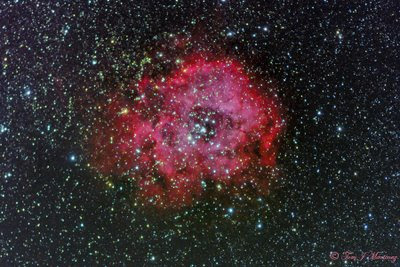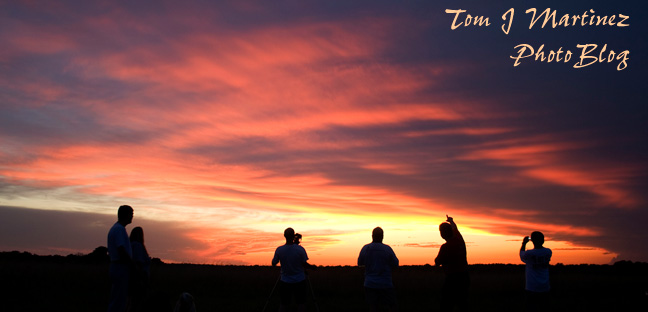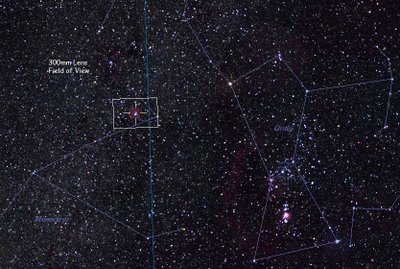I love Springtime. I imagine it is the favorite time of year for most everyone. The freshness of everything growing makes me feel wonderful and alive. I have been taking pictures of the early flowering plants and a few birds. The nice snowstorm we had over the weekend made me get up early to look for some photographic opportunities. I have created a small slideshow of some of these pictures. Click on this link to see it:
http://tomjmartinez.com/winter_spring_slideshow/
Monday, March 30, 2009
Monday, March 23, 2009
Galaxies - Near, Far, and Really Far
All of the pictures you see here were taken with the same lens, my Canon 300mm f/4 telephoto lens. They are all galaxies of various types and sizes. They also vary in incredible distances from us. The image above is the great Andromeda Galaxy (M31), our nearby twin sister. She is our nearest large neighbor, right next door to our own Milky Way galaxy. Someone (or Thing) is standing on one of M31's planets, looking at our galaxy right now and seeing a similar looking spiral of stars, dust and gas. M31 is quite a distance from us (2.5 million light years away), but it is so big, we can see it without optical aide as a fuzzy star in the constellation Andromeda. To see it, however, you need to be away from the light pollution of our cities and is best seen in our Fall and Winter sky. There are two companion galaxies rotating around M31, one fairly obvious on this side and one much smaller directly on the other side. Astronomers have studied it's motion, and it is on a collision course with the Milky Way. To see what this event will look like, see the image of the next galaxy below.
 This the Whirlpool Galaxy, M51 and it's companion NGC5195. Click on the image to get a closer look and notice the the odd shape of the smaller galaxy. NGC5195 has collided with M51. What you are seeing it the stars of the galaxy pushed out and distorted like a water sprinkler. During the collision, the stars in the galaxies usually do not collide. This is because of the great distances between the stars, but gravitational attraction from the passing stars, dust, gas and dark matter, tugs and distorts the galaxies into new shapes. This image was taken with the same lens, but M51 is a smaller image because it is almost ten times further away (23 million light years). Lots of galaxies, even further away are picked up with the one hour exposure. The galaxy numbers you see are from various catalogs. If you know where to look and are away from the city lights, you can see it with a pair of binoculars, looking like a fuzzy star. It sits near the last star of the Big Dipper's handle like in the chart below.
This the Whirlpool Galaxy, M51 and it's companion NGC5195. Click on the image to get a closer look and notice the the odd shape of the smaller galaxy. NGC5195 has collided with M51. What you are seeing it the stars of the galaxy pushed out and distorted like a water sprinkler. During the collision, the stars in the galaxies usually do not collide. This is because of the great distances between the stars, but gravitational attraction from the passing stars, dust, gas and dark matter, tugs and distorts the galaxies into new shapes. This image was taken with the same lens, but M51 is a smaller image because it is almost ten times further away (23 million light years). Lots of galaxies, even further away are picked up with the one hour exposure. The galaxy numbers you see are from various catalogs. If you know where to look and are away from the city lights, you can see it with a pair of binoculars, looking like a fuzzy star. It sits near the last star of the Big Dipper's handle like in the chart below.
 Now we make a big jump. With the same lens (and same field of view), we are looking at galaxies that are about 60 million light years away, 24 times further away than the Andromeda Galaxy. These is a cluster of galaxies, known as the Virgo Cluster (most of them are in the constellation Virgo, now in the Springtime sky). We see quite a few galaxies in this image, but it is only a small part of the close to 2000 galaxies. This cluster is also part of an even larger Supercluster, of which our Milky Way, M31 and a few other galaxies (the Local Group) also belong to. Notice that a few of these galaxies look as big as M51, but this only shows you how huge these galaxies really are to take up the sames view and yet be almost 3 times further away than M51. I labeled the galaxies in the image below using star charting software.
Now we make a big jump. With the same lens (and same field of view), we are looking at galaxies that are about 60 million light years away, 24 times further away than the Andromeda Galaxy. These is a cluster of galaxies, known as the Virgo Cluster (most of them are in the constellation Virgo, now in the Springtime sky). We see quite a few galaxies in this image, but it is only a small part of the close to 2000 galaxies. This cluster is also part of an even larger Supercluster, of which our Milky Way, M31 and a few other galaxies (the Local Group) also belong to. Notice that a few of these galaxies look as big as M51, but this only shows you how huge these galaxies really are to take up the sames view and yet be almost 3 times further away than M51. I labeled the galaxies in the image below using star charting software.It always amazes me how large the sky is above us. It is very hard to comprehend these great distances. It also amazes me that 99% of the people on the Earth never look up at the night sky.
Monday, March 9, 2009
Bald Eagle
Yesterday, I was driving through Swope Park, right in the middle of Kansas City, MO, I was amazed to see this Bald Eagle. He was busy looking down into a pond, trying to make a meal out of a fish I'm sure. I'll have to make sure to look for one whenever I'm in the area.
The photo was taken with my 300mm f/4 IS L lens on my Canon Xti. The IS stands for Image Stabilization. It really helps improve the sharpness of my handheld shots like this one.
Line 'em up! Head 'em out!
I was filling up my gas tank when I spotted these geese and goslings crossing the street. Cars had stopped to let them by. I grabbed my camera and caught them as they were crossing in front of shopping mall stores. They looked so much like kids with their teacher and chaperones out on a field trip. You probably need to scroll the bottom scroll bar to see the whole image.
Taken with my 18-55mm zoom lens at 18mm.
Peek-A-Boo Meadowlark
While camping out last Summer I spotted a Meadowlark playing peek-a-boo with me in the tall prarie grass. I took many shots, but most were almost impossible to tell there was a bird there. Meadowlarks are extremely shy birds and hard to get close to them. This is probably an Eastern Meadowlark, but beacause I live near the edge of the territories between Eastern and Western species, it could be one or the other.
Taken with my 300mm f/4 IS L lens.
Wednesday, March 4, 2009
Winter Rose

All roses are pretty, especially in the Winter sky. Astronomers have named this the Rosette Nebula. It sits in the constellation Monoceros, right next door to Orion (see the constellation diagrams above. The rectangle in the diagram is the area of sky that my 300m lens and camera combination cover in the sky). This a very large nebula, taking up 5 times the area of a full moon, but so faint it is impossible to see unless you are in very dark skies, and even then, special filters are needed at the eyepiece to see its faint nebulosity.
For as big as it is, the Rosette is still very far away, 4500 light years distant. It's diameter is estimated at 130 light years across. Remember, light travels at 180,000 miles per second, so the light you see left that object 4500 years ago. What makes the nebula glow is the cluster of stars in darker center of the rose. High energy light from the bright young stars ionizes the surrounding hydrogen gas clouds to light up the red emission nebula. The hot wind of particles from these stars is also evacuating the cluster center. Slowly, over millions of years, the gas and dust will eventually condense into 10,000 or so stars. A truely remarkable piece of nature that can only be seen at its best in photographs.
****
"The sky is the ultimate art gallery just above us." - Ralph Waldo Emerson (1803 - 82)
"The sky is the ultimate art gallery just above us." - Ralph Waldo Emerson (1803 - 82)
****
Technical Data: I took its picture while waiting for comet Lulin to rise above the treetops, and also to give "First Light" to a new CCD camera. My Canon 300mm f/4 lens was used on a CCD-Labs Q453 camera http://www.ccd-labs.com/Qseries/q453.htm The camers is cooled to -35C beyond ambient temperature. It does this to get rid of noise that is inherent in long exposure imaging. The imaging chip is 23.4mm(h) x 15.6mm(v) APS film equvilent, about .65 smaller than 35mm film. I took 6 images, 10 minutes each. 20 flat frames and 20 bias frames were taken, then all these images were processed in DeepskyStacker and final processing in Photoshop CS2.
Technical Data: I took its picture while waiting for comet Lulin to rise above the treetops, and also to give "First Light" to a new CCD camera. My Canon 300mm f/4 lens was used on a CCD-Labs Q453 camera http://www.ccd-labs.com/Qseries/q453.htm The camers is cooled to -35C beyond ambient temperature. It does this to get rid of noise that is inherent in long exposure imaging. The imaging chip is 23.4mm(h) x 15.6mm(v) APS film equvilent, about .65 smaller than 35mm film. I took 6 images, 10 minutes each. 20 flat frames and 20 bias frames were taken, then all these images were processed in DeepskyStacker and final processing in Photoshop CS2.
Monday, March 2, 2009
Beautiful Snow Day

Saturday morning I woke up to a nice snowfall. We had about 4 or 5 inches on the ground, so I had to go out and play with my camera. Even though it was around 20 degrees, my pond was not frozen, but made an idylic scene. Right before I went back inside I saw a colorful robin fighting the blowing snow. This is only the second time this winter that we have had any significant amount of snow in my area, south of Kansas City. Hopefully we'll have another one before the end of March.
Subscribe to:
Posts (Atom)







